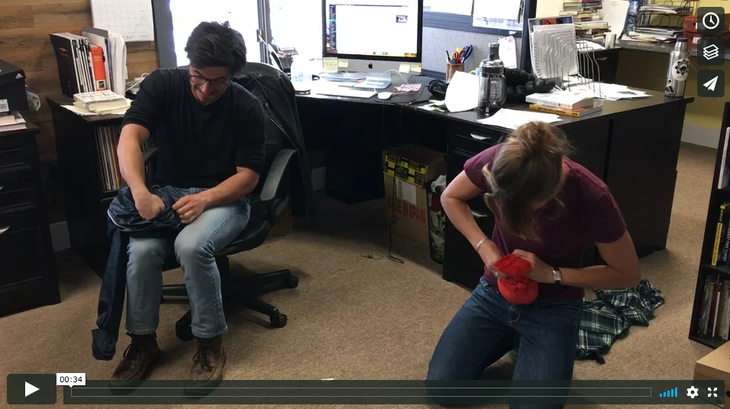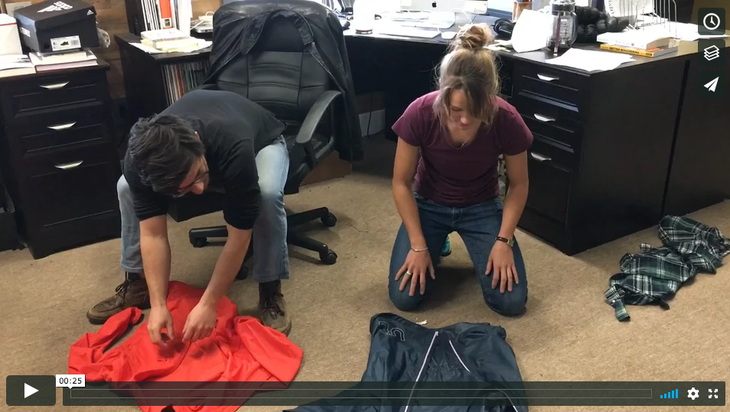New perk! Get after it with local recommendations just for you. Discover nearby events, routes out your door, and hidden gems when you sign up for the Local Running Drop.
Spring showers are hammering parts of the U.S. so we’ve checked out some new models of running shells to help us get to the May flowers. These jackets are super light, packable and keep the elements at bay.
La Sportiva Women’s Briza Windbreaker Jacket
Price: $89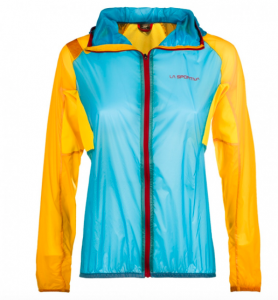
Weight: 2.8 oz
Material: 100% polyamide Rear: 100% polyester
If you’re heading out into the high country, or even just out into questionable weather and want to bring along a lightweight, wind and water-resistant layer, the Briza Windbreaker is an excellent choice.
While the front panels, hood and sleeves keep you sheltered from the elements, mesh panels line the back and armpits allowing for breathability during harder efforts. That being said, don’t expect to be completely dry when you take it off, especially if you are working hard.
The form-fitting, gusseted hood doesn’t budge—tested under 50 mph winds—and the sleeves are long enough to cover your hands if you forget to bring gloves along. This jacket is definitely best for temperatures in the 40—55 degree Fahrenheit range with winds of any speed, any colder and you’ll want a warmer layer or base layer to accompany this piece.
Lastly, this jacket can be discreetly packed into the internal rear pocket and attached with a stretchy cord that can either further compress the jacket or, in a pinch, act as a sort of satchel or backpack. Weighing in at a meagre 2.8 oz, this jacket disappears in a pack or could easily be tucked into shorts or a waist belt.
The men’s version of this jacket is the Blizzard Windbreaker.
—Patricia Franco is based in Carbondale, Colorado. A mountain runner by summer and skimo racer by winter, you can find her somewhere scrambling in the alpine or kick turning her way up a slope to earn some turns, depending on the season.
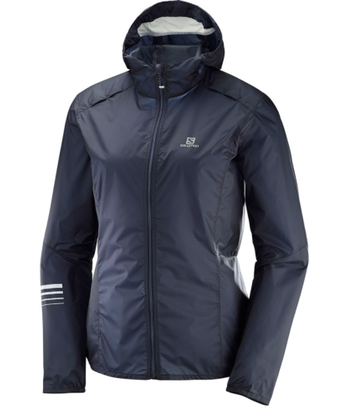
Salomon Women’s Lightning Wind Hoodie Sportiva Women’s
Price: $120
Weight: 3.3 oz
The Lightning Wind Hoodie is a lightweight, packable, full-zip, windbreaker hoodie designed with ventilation in mind. The breathable material and micro-holes in the underarm area allow heat and moisture to escape when cranking up hills, while still keeping the wind out and the DWR treatment helps to repel light showers. I was impressed by how comfortable it kept me while running in the high winds of springtime in the mountains.
Despite being an exceptionally light and packable, the Lightning Wind Hoodie is well structured so it won’t emerge from your pack like a deflated balloon. The Active Fit design is form-fitting and flattering: it doesn’t flap around all over the place (such a nuisance with standard windbreakers!) but still gives you a huge range of motion. The ripstop fabric is also quiet and not at all restrictive—you’ll be free to move without sounding like an empty chip bag.
Additional little details include reflective details to improve visibility, a fitted hood and two pockets. The one drawback is that the zipped lumbar pocket was slightly too small to fit my phone (Samsung Galaxy 7)—I got it in, but it took some effort.
—Jacky Thompson is an avid mountain and desert trail runner. When she isn’t rock climbing, running, foraging or frolicking outside, she can be found practicing yoga and playing music.
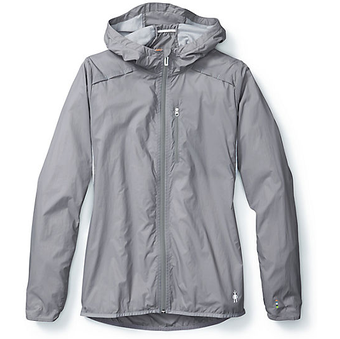 Smartowool Women’s PhD® Ultra Light Sport Jacket
Smartowool Women’s PhD® Ultra Light Sport Jacket
Price: $120
Weight: 5.2 oz
Shell:100% Nylon Side Panels: 54% Merino Wool, 46% Polyester
Wool always seems to win out when it comes to the warmth/breathability balance, and the PhD® Ultralight Sport Jacket from Smartwool is no exception to this rule. The nylon shell that covers your torso and sleeves features small ventilated holes that are covered to keep moisture out, and while this isn’t a rain shell, it will keep you dry in light or misty rain or snow.
The wool/polyester-blend panels under the arms and on the shoulder blades allow for plenty of ventilation, even when pushing hard. I used this jacket over a tee-shirt on a brisk 30 degree morning and found it provided plenty of warmth without leaving me drenched afterwards. If you’ve left behind your hat or buff, no worries, a wool lining inside the hood keeps your ears plenty warm on a chilly outing.
The semi-relaxed fit of this jacket provides plenty of room for a long-sleeve base layer underneath. When you get too warm, stow the jacket away in the chest pocket and it compresses down almost to the size of an iPhone 6, allowing it to fit smoothly into a pack, waist belt or even the elastic band of your shorts.
The men’s specific version of the PhD® Ultra Light Jacket is taylored to a masculine fit and comes without a hood.
—Patricia Franco is based in Carbondale, Colorado. A mountain runner by summer and skimo racer by winter, you can find her somewhere scrambling in the alpine or kick turning her way up a slope to earn some turns, depending on the season.
 Ultimate Direction Deluge Shell
Ultimate Direction Deluge Shell
Weight: 5.4 oz
Material: 20D Nylon Ripstop with Silicone outer and PU inner face
Price: $100
The Deluge Shell by Ultimate Direction is ready for the 10-year storm. It’s non-breathable, waterproof and has a rigid, brimmed hood that keeps shape while running and fends off the downpour. The back vents are key and provide needed ventilation for a jacket that would otherwise trap sweat. There is an elastic pull cord for cinching at the base and the women’s version has built-in elastic in the back for a more fitted style. There are hidden “mitts” (FlipMitts) at the ends of the sleeves for extra hand protection. For this reviewer, the mitts were a lifesaver—my extremities are prone to going numb while running in cold weather, yet another reviewer of the Deluge said he wouldn’t use them.
The hood is where the Deluge sets itself apart from other running jackets. It has interior structure that keeps the brim shaped around your face and elastic pulls keep it snug. It also has rear mesh venting. Sadly, there isn’t an actual opening so for women, a ponytail can’t go through.
The Deluge packs up small into an interior pocket (the only pocket on the jacket) but there isn’t a closure so the rigid hood is resistant to stay tucked in.
Take this beast on long runs in seriously inclement weather.
—Megan Janssen is the Assistant Editor of Trail Runner Magazine
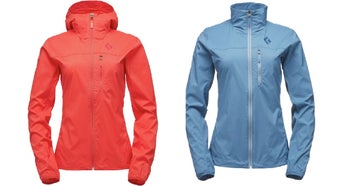 Black Diamond Alpine Start Jacket and Hoody
Black Diamond Alpine Start Jacket and Hoody
Price: $159 for hooded jacket, $149 for standard jacket
Weight: 6.7 oz for women’s hoody, 7.4 oz for men’s
Material: Schoeller® stretch-woven nylon with NanoSphere® Technology (80 gsm, 93% nylon, 7% elastane)
The Alpine Start, available with or without a hood and in both men’s and women’s specific cuts, is a lightweight, no-frills outer layer. Designed to protect from wind gusts and light weather this minimal jacket provides an excellent extra layer—worn over insulating mid-layers or simply a t-shirt. The jacket deflects very light rain or misty precipitation, but don’t expect it to keep you dry in downpours.
This line of jackets is also designed for rock climbing and alpinism and, as such, the gusseted arms and soft, stretchy fabric ensure complete and unrestricted range of movement while running; furthermore, the elasticated cuffs and drawcord hem help keep the jacket in place. Another upside to the multi-use design of this jacket is that the material is extremely tough and can easily withstand brushes with branches and snagging foliage on the trails.
With a single small chest pocket, into which the jacket can easily be stowed, the jacket is certainly minimal—don’t expect to carry more than your phone and a bar with you—but this makes it a neat and easy addition to your pack. This isn’t the lightest jacket in this series but it is almost certainly the toughest.
As a protective layer, the Alpine Start is breathable but doesn’t host any ventilation features, which may turn some runners against it; however it is appropriate for any number of outdoor sports and so would be an excellent crossover jacket for those with multiple outdoor hobbies.
Men’s Hoody Buy Now Men’s Jacket Buy Now
Women’s Hoody Buy Now Women’s Jacket Buy Now
—Harriet Ridley is Editorial Fellow at Rock and Ice Magazine and travels all over the southwest U.S. testing outdoor gear.
Here’s the editorial crew in some healthy jacket-stuffing competition.
